See also
Occupy articles
Other U.S. protests | Related articles |
|
| Occupy San Diego | |
|---|---|
| Part of the "Occupy" protests | |
| Date | October, 7th 2011 – June 2012 |
| Location | |
| Caused by | Economic inequality, corporate influence over government |
| Methods | Demonstration, occupation, protest, street protesters |
| Injuries/Arrests | |
| Injuries | 0 |
| Arrested | 139 |
Occupy San Diego was one of the many occupation protest movements in the United States. Located in San Diego, California, the protest movement initially began in the city's downtown district at the Civic Center. According to authorities, it had "a growing problem with violence and mounting trash". However this assertion was disputed by protesters and eyewitnesses, since Occupy protesters have been actively cleaning the site since October, 2011. [1] It is based on the Occupy Wall Street movement that began in New York City on September 17 and is one of several "Occupy" protest sites in Southern California, including Occupy Los Angeles.
As of June 2012, Occupy San Diego had continued to engage in organized meetings, events and actions. [2]
Occupy San Diego started on October 7, when protesters gathered in Children's Park in downtown San Diego. Plans were made to occupy the Civic Center, but out of respect for the Jewish community's observation of Yon Kippur the occupation was moved to the park for the weekend. Occupy San Diego officially moved to the Civic Center that Sunday evening - October 9. The occupation sustained an encampment in the Plaza for a week, until police issued a warning instructing the protesters to clear out on the evening of Thursday, October 14. On Monday, October 10, a man jumped from the top floor of a parking garage in what was later revealed to have been a suicide. [3] That put to rest some of the speculation that it was linked to violence on behalf of protesters.
On Friday, October 28, at approximately 2:00am, the San Diego Police and Sheriff's Department raided the OSD camps at the Civic Center and Children's Park, making 51 arrests. [4] Women who were arrested were subjected to police brutality, and the men who were arrested were brought from the Civic Center to Vista Detention Facility 42 miles away, where they were kept on a bus for over 8 hours, denied bathrooms and water, and forced to urinate in the bus. All charges were dropped in the vast majority of arrests. [5] In 2013, multiple lawsuits were filed against the City and County of San Diego alleging unlawful arrest, police brutality, and other civil rights violations stemming from the October 28 arrests. [6] The lawsuits were settled out of court.
On November 30, protesters clashed with police as protesters set up a voter registration table. The day before, San Diego police arrested former democratic congressional candidate Ray Lutz for setting up a similar voting registration table, Lutz cited a California Supreme Court ruling which in part states that people are allowed to register voters, even on private property. [7]
Nine protesters were arrested on Dec. 5, 2011, including one who had to be removed from a tree. [8]
On December 12, Occupy San Diego protesters joined with other occupy movements across the west coast in an attempt to shut down the ports in San Diego. About one hundred people showed up to the event, and four people were arrested. [9]
Three protesters were arrested on December 22 while they were in their sleeping bags, a fourth man was arrested for recording the police activity with a camera. This brought the total number of arrests related to the movement in San Diego to 139. [10]
Occupy articles
Other U.S. protests | Related articles |
|
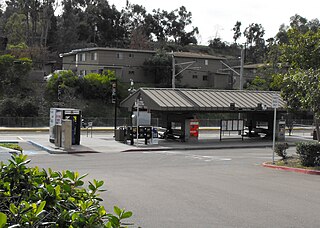
La Mesa is a city in San Diego County, California, located nine miles east of downtown San Diego in Southern California. The population was 61,121 at the 2020 census, up from 57,065 at the 2010 census. Its civic motto is "the Jewel of the Hills."

Sorrento Valley is a neighborhood of San Diego, California. It is roughly bounded by Interstate 5 and Interstate 805, Camino Santa Fe to the east, the Los Peñasquitos Canyon Preserve to the north and Miramar Road to the south, as shown on the San Diego Police Department's neighborhood map. It encompasses Sorrento Mesa and is part of San Diego Unified School District.
The San Diego free speech fight in San Diego, California, in 1912 was one of the most famous class conflicts over the free speech rights of labor unions. Starting out as one of several direct actions known as free speech fights carried out across North America by the Industrial Workers of the World, the catalyst of the San Diego free speech fight was the passing of Ordinance No. 4623 that banned all kinds of speech in an area that included "soapbox row" downtown. Clashes with the police in the area led to riots, multiple deaths including the deaths of police officers, vigilantism, and the retaliatory kidnapping and torture of notable socialists, including Emma Goldman's manager Ben Reitman. As a direct result of the aftermath of this fight, the neighborhood of Stingaree was razed to the ground and the obliteration of San Diego's Chinatown.

Occupy Los Angeles was one of the many occupy movements in the United States, following the original Occupy Wall Street (OWS) protest. Participants of Occupy L.A. first met at Pershing Square on September 23, 2011. Activists came to consensus to occupy public space in solidarity with the growing movement. Occupiers first marched in Los Angeles on September 24, 2011. They next protested a fundraiser being held in Hollywood at the House of Blues for President Obama. Participants met at Pershing Square every subsequent night to plan out the logistics of an occupation set to begin on October 1, 2011. After debating potential locations around Los Angeles, people decided on the lawns around City Hall. Tents first manifested on October 1, 2011 on the grounds of Los Angeles City Hall.
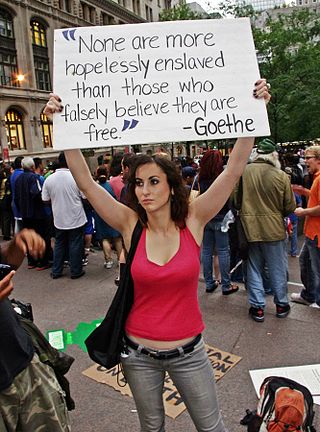
The following is a timeline of Occupy Wall Street (OWS), a protest which began on September 17, 2011 on Wall Street, the financial district of New York City and included the occupation of Zuccotti Park, where protesters established a permanent encampment. The Occupy movement splintered after NYC Mayor Bloomberg had police raid the encampment in Zuccotti Park on November 15, 2011. The timeline here is limited to this particular protest during this approximate time-frame.

Occupy Portland was a collaboration that began on October 6, 2011, in downtown Portland, Oregon, as a protest and demonstration against economic inequality worldwide. The movement was inspired by the Occupy Wall Street movement that began in New York City on September 17, 2011.

Occupy San José was a peaceful protest and demonstration in City Hall Plaza in San Jose, California. The demonstration was inspired by Occupy Wall Street and is part of the larger "Occupy" protest movement. The aim of the demonstration was to begin a sustained occupation in downtown San José, the 10th largest city in the United States, to protest perceived corporate greed and social inequality, including opposing corporate influence in U.S. politics, the influence of money and corporations on democracy and a lack of legal and political repercussions for the 2007–2008 financial crisis.

The Occupy movement was an international populist socio-political movement that expressed opposition to social and economic inequality and to the perceived lack of real democracy around the world. It aimed primarily to advance social and economic justice and different forms of democracy. The movement has had many different scopes, since local groups often had different focuses, but its prime concerns included how large corporations and the global financial system control the world in a way that disproportionately benefits a minority, undermines democracy and causes instability.
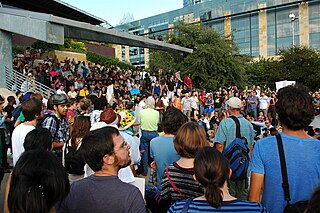
Occupy Austin was a collaboration that began on October 6, 2011 at City Hall in Austin, Texas as an occupation and peaceful protest. It is affiliated with the Occupy Wall Street movement that began in New York City, and also with the "Occupy" protests in the United States and around the world. At the center of the occupation is the General Assembly, where the community comes out and tries to come to consensus on proposals for action.
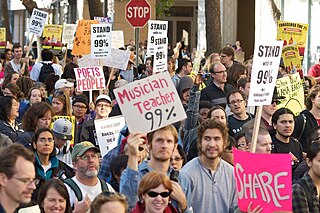
Occupy Oakland refers to a collaboration and series of demonstrations in Oakland, California, that started in October 2011. As part of the Occupy movement, protesters have staged occupations, most notably at Frank H. Ogawa Plaza in front of Oakland City Hall.

Occupy Houston is a Houston, Texas-based activist group best known for alleged plots against it by the Federal Bureau of Investigation, investigated and called out on in court by Occupy protester Ryan Shapiro, and for being set up by the Austin Police Department. Occupy Houston was a collaboration that has included occupation protests that stand in solidarity with Occupy Wall Street. The planned occupation officially started in Houston, Texas on Thursday October 6, 2011 when protesters returned from JP Morgan Chase Tower to establish an encampment at Hermann Square Plaza. During the JPMorgan Chase demonstration there were not any confrontations with the police and numerous different passerby were reported to have sympathized with the tone of the protesters. That same night the police were reported to have commented on how well behaved the protesters were.

Occupy San Francisco was a collaboration that began with a demonstration event located at Justin Herman Plaza in the Embarcadero and in front of the Federal Reserve building on Market Street in the Financial District in San Francisco, California. It is based on the Occupy Wall Street movement that began in New York City on September 17, 2011 and is one of several "Occupy" protest sites in the San Francisco Bay Area; other sites include Occupy Oakland and Occupy San Jose.

The Occupy movement spread to many other cities in the United States and worldwide beginning with the Occupy Wall Street protests in New York City in September 2011. The movement sought to advance social and economic justice and different forms of democracy but each local group varied in specific aims. The demonstrations and encampment in New York City spread to other major and smaller cities. Some camps lasted through 2012. What follows is an alphabetical, non-chronological summary of Occupy encampments in the United States.
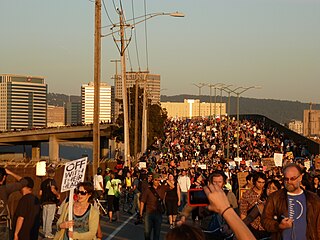
The following is a timeline of Occupy Oakland which began on Monday, October 10, 2011, as an occupation of Frank H. Ogawa Plaza located in front of Oakland City Hall in downtown Oakland, and is an ongoing demonstration. It is allied with Occupy Wall Street, which began in New York City on September 17, 2011, and is one of several "Occupy" protest sites in the San Francisco Bay Area. Other sites include Occupy San Francisco and Occupy San Jose.
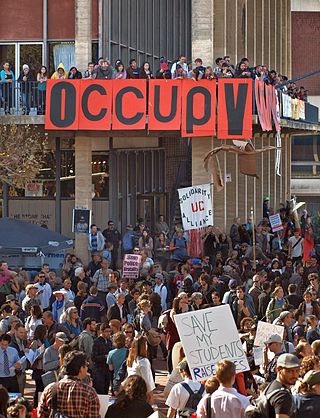
Occupy Cal included a series of demonstrations that began on November 9, 2011, on the University of California, Berkeley campus in Berkeley, California. It was allied with the Occupy Wall Street movement in New York City, San Francisco Bay Area Occupy groups such as Occupy Oakland, Occupy Berkeley, and Occupy San Francisco, and other public California universities. "Cal" in the name "Occupy Cal" is the nickname of the Berkeley campus and generally refers specifically to UC Berkeley.

The San Francisco Public Defender's Office is an agency of the Government of San Francisco. Since 1921, it has provided legal assistance to indigent individuals charged with violations of California state law by the San Francisco District Attorney's Office.
The 2014 Oakland riots were a series of riots and civil disturbances that took place in Oakland, California and surrounding areas in November and December 2014. On November 24, 2014, following the decision of a Grand Jury in St. Louis to not charge Darren Wilson in the shooting death of black teenager Michael Brown, protests and rioting broke out in Oakland and later spread to other Bay Area cities. For more than two weeks, the Bay Area was the site of civil unrest as protesters clashed with police and damaged public and private property.
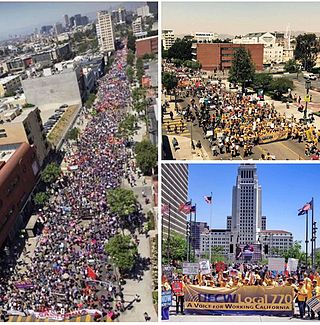
The 2017 May Day protests were a series of protests that took place on May Day over worker and immigrant rights, throughout the United States and around the world. Protests became violent in Olympia, Washington, and Portland, Oregon. Many demonstrators were protesting against the policies of President Donald Trump, specifically those related to immigration.

This is a list of protests that took place in San Diego County, California, following the murder of George Floyd that took place on May 25, 2020 in Minneapolis, Minnesota, after police officer Derek Chauvin knelt on his neck for 9 minutes and 29 seconds. These events were created to fight for justice for George Floyd and other Black community members who suffer from police brutality. These demonstrations resulted in a number of policy changes, namely the ban of the cartoid neck restraints use in San Diego County and a city-wide independent review board that would review police practices.
{{cite web}}: CS1 maint: unfit URL (link)